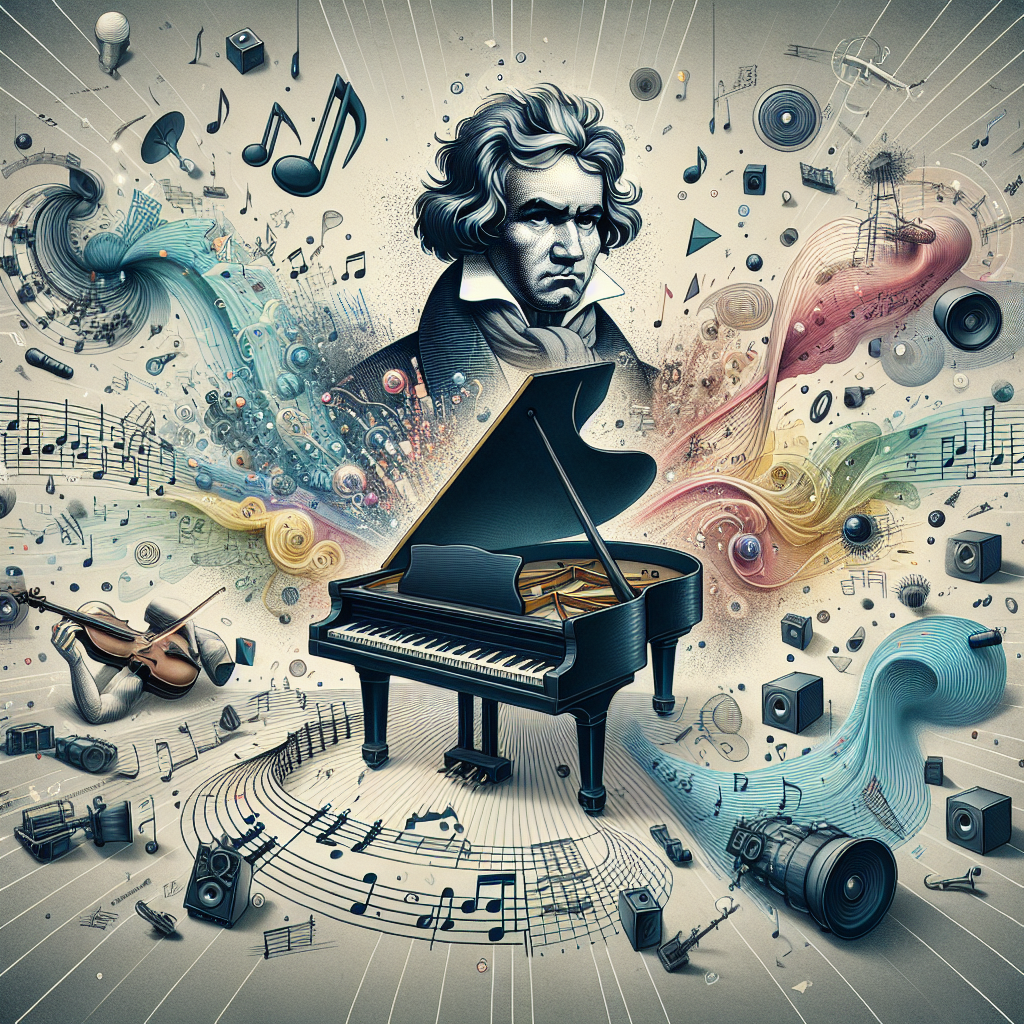
Beethoven’s Concerto Style – Innovation and Influence
Ludwig van Beethoven, a towering figure in the history of classical music, fundamentally altered the landscape of Western music with his profound and innovative compositions. Born in Bonn, Germany in December 1770, Beethoven showed prodigious musical talent from an early age. His father, a musician from the court, recognized his son’s potential and provided early music education, albeit with a harsh regimen. This early foundation laid the groundwork for a career that would challenge and redefine musical norms.
Beethoven’s body of work is expansive, ranging from symphonies to string quartets, and everything in between. Perhaps some of his most compelling and diverse compositions are his concertos. His concertos not only encapsulated his creative genius, but also acted as bridges between the Classical and Romantic eras in music. The concertos reflect his evolving musical style, characterized by emotional depth, technical innovation, and a robust exploration of musical form and structure.
From the lyrical serenity of his Piano Concerto No. 1 to the grandeur of the “Emperor” Concerto, Beethoven’s concerto style embodies a relentless quest for expressive richness and technical mastery. This article will delve into the specifics of Beethoven’s concerto style, examining how his works in this genre have influenced subsequent generations of composers and performers. By understanding the essence of his concerto style, we gain a more comprehensive appreciation of his overall contribution to music.
Early Concertos and Classical Roots
Beethoven’s earliest concertos, such as Piano Concerto No. 1 in C major, Op. 15, and Piano Concerto No. 2 in B-flat major, Op. 19, are firmly rooted in the Classical tradition set by his predecessors, Mozart and Haydn. These works exhibit a traditional three-movement structure and maintain a sense of balance and clarity typical of the Classical style. However, they also hint at Beethoven’s burgeoning innovations.
In Piano Concerto No. 1, Beethoven’s mastery of the form is evident in the brisk, energetic first movement, the lyrical and expressive second movement, and the spirited and exuberant finale. The concerto displays a balance between the soloist and orchestra, a hallmark of the Classical concerto tradition. Despite these Classical elements, there are moments where Beethoven’s unique voice emerges, foreshadowing his later works.
Piano Concerto No. 2, although numbered second, was composed earlier than its predecessor. It similarly adheres to Classical norms but also showcases Beethoven’s developing individuality. The second movement, for instance, features a lyrical, almost improvisatory quality that would become a signature aspect of Beethoven’s later works. The finale, too, is marked by brilliant and playful pianistic passages that push the boundaries of Classical form.
Overall, Beethoven’s early concertos exhibit his firm grounding in the Classical style while also revealing innovations that would become more pronounced in his mature works. These compositions show a composer at the cusp of a transformative musical journey, setting the stage for the evolutionary leaps seen in other concertos of his middle and late periods.
The Heroic Middle Period
Beethoven’s middle period, often referred to as his “Heroic” phase, is characterized by dramatic contrasts, expanded forms, and heightened emotional expression. This period saw the creation of his Piano Concerto No. 3 in C minor, Op. 37, Piano Concerto No. 4 in G major, Op. 58, and the Violin Concerto in D major, Op. 61. Each of these works represents a significant advancement in the concerto form, pushing the boundaries of musical structure and expression.
Piano Concerto No. 3, written during a time of personal and physical struggle for Beethoven, is imbued with a pronounced sense of drama and urgency. The choice of C minor, a key Beethoven often associated with stormy and intense emotions, sets the tone for a concerto marked by its bold and powerful statements. The interplay between the soloist and the orchestra is more dynamic and complex compared to his earlier concertos, showcasing Beethoven’s evolving musical ideas.
Piano Concerto No. 4, in contrast, presents a more introspective and lyrical side of Beethoven’s style. The concerto opens with a simple, yet profoundly expressive solo piano passage, creating a sense of intimate dialogue between the soloist and the orchestra. This concerto is often lauded for its poetic and innovative qualities, particularly in the second movement, where the piano and orchestra engage in a dramatic and almost conversational exchange.
The Violin Concerto in D major is another hallmark of Beethoven’s middle period. It is a work of considerable grandeur and depth, often described as one of the greatest violin concertos ever composed. The concerto opens with a strikingly lyrical orchestral introduction, setting the stage for the soloist’s entrance. Beethoven’s use of thematic development, expansive orchestration, and virtuosic demands on the soloist marked a significant departure from the established norms of violin concertos of his time.

The “Emperor” Concerto and Late Period Innovations
Perhaps the most iconic of Beethoven’s concertos is his Piano Concerto No. 5 in E-flat major, Op. 73, known as the “Emperor” Concerto. Composed during the early 1800s, the “Emperor” Concerto stands as a pinnacle of Beethoven’s concerto style and represents the culmination of his innovative efforts in this genre. The concerto’s nickname, though not given by Beethoven himself, aptly reflects its grand and majestic character.
The “Emperor” Concerto opens with an instantly recognizable and powerful orchestral tutti, immediately engaging the listener. This is followed by dazzling piano passages that showcase Beethoven’s virtuosic skill as both a composer and performer. The first movement is marked by a sense of heroic struggle and triumph, a recurring theme throughout Beethoven’s middle and late works.
The second movement, in stark contrast, offers a moment of serene beauty and introspection. Its lyrical melody and delicate orchestration provide a poignant respite before the lively and exuberant finale bursts forth with an infectious energy. The balance between grandeur and intimacy, complexity and clarity, is a testament to Beethoven’s supreme command of the concerto form.
In his later years, Beethoven’s hearing loss became profound, and his compositions took on new dimensions of abstraction and emotional depth. Although he composed fewer concertos during this period, works like the “Emperor” Concerto continued to influence and inspire subsequent generations of musicians and composers. Beethoven’s later concertos embody his relentless pursuit of innovation, pushing the limits of musical expression and technical prowess.
Influence on Subsequent Composers
Beethoven’s concertos left an indelible mark on the world of Western classical music, influencing numerous composers who followed. His approach to thematic development, structural innovation, and expressive depth set a new standard for concertos. Composers such as Johannes Brahms, Pyotr Ilyich Tchaikovsky, and Sergei Rachmaninoff, to name a few, drew inspiration from Beethoven’s model while adding their unique voices to the genre.
Johannes Brahms, often regarded as a musical heir to Beethoven, composed concertos that reflect a deep understanding and reverence for Beethoven’s work. His Piano Concerto No. 1 in D minor, Op. 15, and Violin Concerto in D major, Op. 77, exhibit a complexity and emotional depth reminiscent of Beethoven’s concertos. Brahms’ use of thematic development and integration of soloist and orchestra echo Beethoven’s innovative spirit.
Similarly, Pyotr Ilyich Tchaikovsky’s Piano Concerto No. 1 in B-flat minor, Op. 23, with its grandiose opening chords and lyrical passages, showcases the influence of Beethoven’s heroic and lyrical styles. Tchaikovsky’s violin concertos also bear the imprint of Beethoven’s structural and expressive innovations, pushing the boundaries of violin technique and musical storytelling.
Sergei Rachmaninoff’s piano concertos, known for their virtuosic demands and lush harmonies, owe much to Beethoven’s pioneering work. Rachmaninoff’s concertos are marked by their dramatic intensity and intricate interplay between the soloist and orchestra, a hallmark of Beethoven’s concerto style. The influence of Beethoven’s lyrical second movements and grand finales is particularly evident in Rachmaninoff’s compositions.
Through these examples and countless others, it is clear that Beethoven’s concerto style created a blueprint for future generations. His relentless pursuit of innovation and expressive depth transcended his era, shaping the trajectory of Western classical music and leaving a lasting legacy.
Conclusion
Ludwig van Beethoven’s contributions to the concerto genre are nothing short of monumental. His early works laid a foundation grounded in the Classical tradition, while his middle and late period concertos represented groundbreaking developments in musical form, structure, and expression. Beethoven’s ability to balance technical virtuosity with emotional depth has made his concertos enduring masterpieces that continue to captivate audiences and inspire musicians worldwide.
The evolution of Beethoven’s concerto style, from the Classical elegance of his early works to the heroic and introspective qualities of his later compositions, reflects his journey as an artist and innovator. Each concerto stands as a testament to his genius and unyielding pursuit of artistic excellence. The “Emperor” Concerto, in particular, epitomizes the grandeur and scope of Beethoven’s vision, serving as a crowning achievement in his concerto oeuvre.
The impact of Beethoven’s concertos extends far beyond his lifetime, influencing countless composers and shaping the future of Western classical music. His innovative approach to thematic development, orchestration, and emotional expression set a new standard that continues to inspire and challenge musicians today. Through his concertos, Beethoven not only redefined the possibilities of the form but also left an indelible mark on the history of music.
In conclusion, Ludwig van Beethoven’s concerto style stands as a beacon of innovation and influence. His masterful integration of technical prowess, emotional depth, and structural innovation set him apart as a true musical pioneer. The legacy of Beethoven’s concertos endures, inspiring generations of musicians and enriching the world of classical music with their timeless beauty and profound expressiveness.